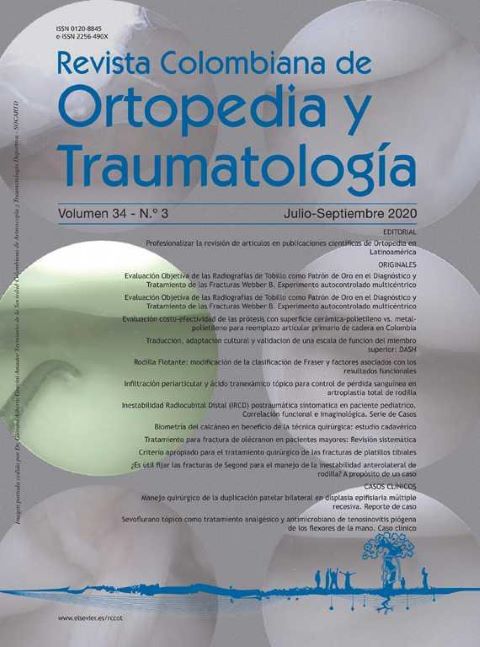Cost-Effectiveness of Ceramic-Polyethylene Vs Metal-Polyethylene Bearing for Primary Total Hip Replacement in Colombia
DOI:
https://doi.org/10.1016/j.rccot.2020.10.002Keywords:
total hip replacement, cost analysis, ceramic, metal, highly cross-linked polyethyleneAbstract
Background: There is a statistically significant difference of 1.2% in the revision rate in a 15 year follow in favour of the use of ceramic on highly cross-linked polyethylene (CP) recently described in the Australian National Joint Registry. The purpose of this study is to compare the cost-effectiveness of CP implants and metal-on-highly cross-linked polyethylene (MP) implants
in patients undergoing total hip replacement (THR).
Materials and methods: A TreeAge Pro® decision tree was constructed in order to determine cost-effectiveness between two bearing surfaces: CP or MP from the perspective of the Colombian Health Care System (CHCS). The model parameters where taken from the best available evidence. For the effectiveness, a systematic review of the literature was performed, and costs were taken from local market rates. The incremental cost-effectiveness ratio was determined assuming a time horizon of 15 years, and a discount rate of 5% was used for costs and effectiveness. Cost-effectiveness uncertainty was controlled with deterministic and probabilistic sensitivity analysis.
Results: For the CHCS, with a 1PIB per capita threshold adjusted per QALY in adults undergoing (THR), the use of a CP implant is not cost-effective, given that the effectiveness is similar (11.32 QALY for MP vs 11.36 QALY for CP), and the cost is three times higher (MP $ 861.826 COP vs CP $ 2.298.090 COP). The deterministic sensitivity analysis showed that the most important variable in the results is the ceramic cost.
Discussion: for the CHCS the routine use of ceramic-highly cross-linked polyethylene bearing surface in a THR is not a cost-effective strategy.
Evidence Level: I
Downloads
References
Koenig L, Zhang Q, Austin MS, Demiralp B, Fehring TK, Feng C, et al. Estimating the Societal Benefits of THA After Accounting for Work Status and Productivity: A Markov Model Approach. Clin Orthop Relat Res. 2016;474:2645-54.
Keurentjes JC, Van Tol FR, Fiocco M, Schoones JW, Nelissen RG. Minimal clinically important differences in health-related quality of life after total hip or knee replacement: A systematic review. Bone Joint Res [Internet]. 2012;1:71-7. Available from: http://www.pubmedcentral.nih.gov/articlerender.fcgi?artid=3626243&tool=pmcentrez&rendertype=Abstract.
Augustovski F, García Martí S, Pichon-Riviere A. Estándares Consolidados de Reporte de Evaluaciones Económicas Sanitarias: Versión en Espanol ˜ de la Lista de Comprobación CHEERS. Value Heal Reg Issues. 2013;2:338-41.
Moreno Viscaya M, Mejía Mejía A, Castro Jaramillo HE. Manual para la elaboración de evaluaciones económicas en salud. Instituto de Evaluación Tecnológia en Salud. 2014.
Mckesson. Annual Report 2017. 2017.
Rothwell A, Oakley A, Larmer P, Hobbs T, Rothwell A. THE NEW ZEALAND Annual Report Editorial Committee. 2015 (January 1999).
INSTITUTO DE SEGUROS SOCIALES. Acuerdo 256 De 2001. Internet [Internet]. 2001;001(256):1-208. Available from: https://lexsaludcolombia.files.wordpress.com/2010/10/tarifasiss-2001.pdf.
Saikko VO, Paavolainen PO, Slätis P. Wear of the polyethylene acetabular cup: Metallic and ceramic heads compared in a hip simulator. Acta Orthop. 1993;64:391-402.
Cash DJW, Khanduja V. The case for ceramic-on-polyethylene as the preferred bearing for a young adult hip replacement. HIP Int. 2014;24:421-7.
Cohn RM, González Della Valle A, Peterson M, Cornell CN. Similar wear in total hip arthroplasties with metallic or zirconia femoral heads. HSS J. 2008;4:107-11.
Carnes KJ, Odum SM, Troyer JL, Fehring TK. Cost Analysis of Ceramic Heads in Primary Total Hip Arthroplasty. J Bone Joint Surg Am. 2016;98:1794-800.
Steven M, Kurtz., Edmund., Lau., Doruk., Baykal., Brya D, Thomas K, Fehring. Are Ceramic Bearings Becoming CostEffective for all Patients? J arthroplasty. 2018;33:1352-8, http://dx.doi.org/10.1016/j.arth.2017.12.011.





